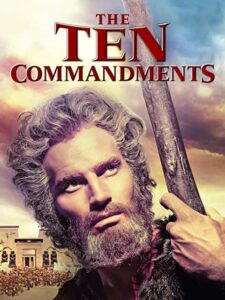 Did you ever wonder why the movie “The Ten Commandments” is always shown at Easter? One explanation is that the Jewish Passover celebration falls at the same time. The final plague on Egypt in the story of the Ten Commandments is the plague that resulted in the Passover tradition. Although on the surface the movie seems to have no relation to Easter, I have found that the retelling of the meaning of the Passover in the movie can have great meaning for Christians at Easter time. When I began seriously studying the Bible on my own, one of the first things that struck me was the fact that Jesus was crucified during the Jewish Passover Festival. Why had I never really thought about it, and why didn’t I remember it ever having been explained? God’s planning is so amazing. What a beautiful foreshadowing of Christ’s death the Passover was.
Did you ever wonder why the movie “The Ten Commandments” is always shown at Easter? One explanation is that the Jewish Passover celebration falls at the same time. The final plague on Egypt in the story of the Ten Commandments is the plague that resulted in the Passover tradition. Although on the surface the movie seems to have no relation to Easter, I have found that the retelling of the meaning of the Passover in the movie can have great meaning for Christians at Easter time. When I began seriously studying the Bible on my own, one of the first things that struck me was the fact that Jesus was crucified during the Jewish Passover Festival. Why had I never really thought about it, and why didn’t I remember it ever having been explained? God’s planning is so amazing. What a beautiful foreshadowing of Christ’s death the Passover was.
In the 12th chapter of the book of Exodus, it is recorded that God was sending the last and greatest plague on Egypt—death for all the firstborn. But He told Moses that any of the Israelites who would slay a perfect lamb and spread its blood over their doorpost would be spared from the plague. The death angel would pass over their homes without bringing death to their firstborn. After the death angel passed over Egypt, there was wailing throughout the land, except in Goshen, where the Israelites resided. The Israelites were to commemorate this event as the “Passover Festival” every year from then on.
Jesus was the perfect Lamb who was slain for our sins. The Passover lamb who protected the Israelites from the death of their firstborn had to be without blemish. The Lamb who was slain to pay for our sins had to be without sin. When John the Baptist saw Jesus coming, he proclaimed, “Look, the Lamb of God, who takes away the sin of the world!” (John 1:29B) If we, by faith, apply the blood of Jesus to the “doorposts” of our hearts, God’s judgment of eternal punishment will pass us by. It reminds me of a hymn we used to sing called “When I See the Blood.” The first verse says, “Christ our Redeemer died on the cross, Died for the sinner, paid all his due; Sprinkle your soul with the blood of the Lamb, ‘And I will pass, will pass over you.’ ” Then the chorus says, “‘When I see the blood, When I see the blood, When I see the blood, I will pass, I will pass over you.’ ” Apparently it hadn’t occurred to me in earlier years that the song was making a comparison to the Passover. It also occurred to me later that after the death angel passed over, the Israelites were freed from being slaves to the Egyptians. Similarly, after appropriating Christ’s sacrifice through faith, we are freed from being slaves to sin.
In the last part of I Corinthians 5:7, the Scriptures themselves say, “For Christ, our Passover lamb, has been sacrificed.” On the night of the Passover, the Israelites were to eat their bread in haste, without using yeast and waiting for the bread to rise. Verses 6 to 8 of I Corinthians 5 talk about avoiding yeast, comparing the yeast in bread to boastfulness, hatred, and wickedness, and bread without yeast to sincerity and truth. It’s another meaningful illustration from the Passover Supper.
One interesting consideration about the picture of the crucifixion of Jesus provided by the Passover lamb is the timing. It’s possible that Jesus was crucified at the exact time that the Passover lambs were being slain. The historian Josephus stated that the Passover lambs were slain between the 9th and 11th hours. For the Jews each new 24-hour day began at sundown. The time during daylight hours was calculated by counting the hours from dawn. So the 9th to 11th hours was equivalent to our 3 PM to 5 PM. Matthew 27:45-50 and Mark 15:33-37 tell us that at the 6th hour (noon our time), while Jesus was on the cross, a strange darkness fell. At the 9th hour (3 PM our time) Jesus cried out, “My God, my God, why have you forsaken me?” Shortly thereafter He died. That was the time they began slaying the Passover lambs. (John 19:13&14 says that Pilate handed Jesus over to be crucified at the 6th hour. John was apparently recording Roman time. We use the Roman system of time calculation, so the 6th hour meant 6 AM. Although John’s account doesn’t mention it, Jesus was probably taken to Herod after that, before being handed over by Pilate for crucifixion.)
timing. It’s possible that Jesus was crucified at the exact time that the Passover lambs were being slain. The historian Josephus stated that the Passover lambs were slain between the 9th and 11th hours. For the Jews each new 24-hour day began at sundown. The time during daylight hours was calculated by counting the hours from dawn. So the 9th to 11th hours was equivalent to our 3 PM to 5 PM. Matthew 27:45-50 and Mark 15:33-37 tell us that at the 6th hour (noon our time), while Jesus was on the cross, a strange darkness fell. At the 9th hour (3 PM our time) Jesus cried out, “My God, my God, why have you forsaken me?” Shortly thereafter He died. That was the time they began slaying the Passover lambs. (John 19:13&14 says that Pilate handed Jesus over to be crucified at the 6th hour. John was apparently recording Roman time. We use the Roman system of time calculation, so the 6th hour meant 6 AM. Although John’s account doesn’t mention it, Jesus was probably taken to Herod after that, before being handed over by Pilate for crucifixion.)
One thing that confuses the issue of the timing of the Passover lamb slaughter is that John 18:28 and 19:14 indicate that the day Jesus was handed over to be crucified the Jewish leaders were preparing for the Passover Supper. On the other hand, Matthew 26:27, Mark 14:12, Luke 22:7-8, and John 13:1-2 seem to show that Jesus and His twelve disciples prepared for their Passover Supper the day before the crucifixion. After reading some discussion of this apparent contradiction, the most logical explanation seems to me to be one found when researching the question “Was the Last Supper a Passover Seder?” at the bible.org website. It stated that the Pharisees and the Sadducees, two different Jewish religious sects, used two different calendar calculations to arrive at the date of the Passover Supper. Their calculations were one day apart. It seems to me that God, in His perfect planning, could possibly have used one day to allow Jesus and His disciples to fulfill the command to observe the Passover Supper and the other day to allow Jesus to be the perfect fulfillment of the Passover lamb foreshadowing. Whether or not Jesus was crucified at the exact time the Passover lambs were being killed, the fact that He died during the Passover Festival is significant.
While thinking of preparing to write this article, I “happened” to turn on a Christian network and hear someone speaking about the Passover lamb. Something she said really caught my attention. I don’t know whether she was expressing her own thought or someone else’s, but to me it was profound. According to Exodus 20:3&6, the Israelites were to select a Passover lamb on the 10th day of the month and take care of it until they slaughtered it on the 14th day of the month. Perhaps caring for the lamb that they would have to slaughter in several days made them develop an attachment to the lamb. It could then give them a small taste of the way God felt when He allowed His beloved Son to be slain.
Scriptures taken from the Holy Bible, New International Version®, NIV®. Copyright ©1973, 1978, 1984, 2011 by Biblica, Inc.TM Used by permission of Zondervan. All rights reserved worldwide. www.zondervan.com The “NIV” and “New International Version” are trademarks registered in the United States Patent and Trademark Office by Biblica, Inc.
Why not take a few moments to worship the Lamb of God who was slain for our sins? Click on the Youtube picture below to worship with the congregation and choir of the Brooklyn Tabernacle.






Leave A Comment